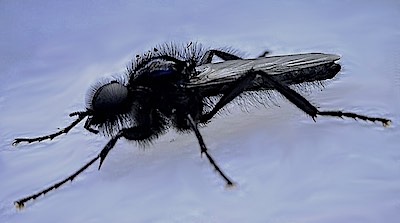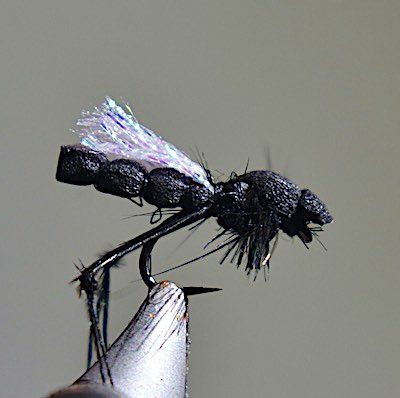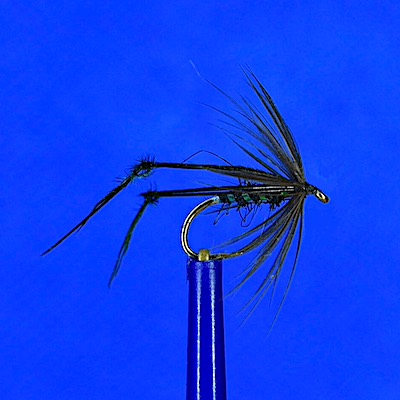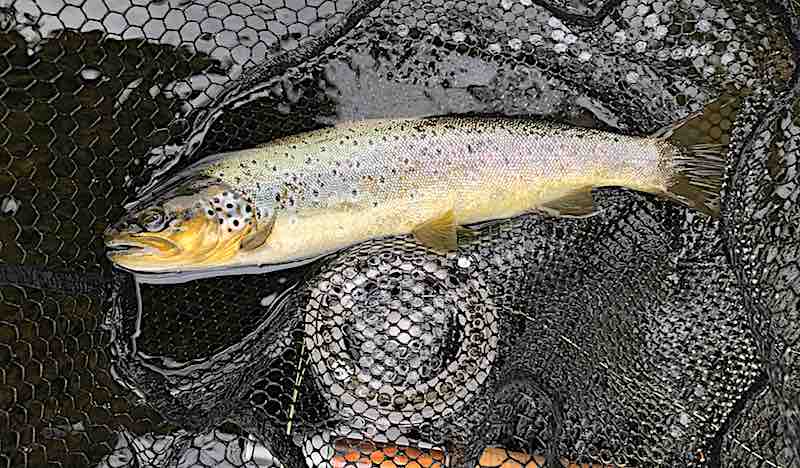The Hawthorn fly, Bibio Marci, is a small, black, and shiny terrestrial fly that appears towards the end of April. It is also known as The St. Mark’s Fly because large hatches often occur around St. Marks Day (25th of April).
As a trout fly angler…
it’s the 1st terrestrial fly I’m interested in…
Therefore, towards the end of April, it is definitely worth having a few suitable patterns in your fly box for trout fishing on rivers and stillwaters because these drowning flies often cause trout to rise.
Hawthorn fly life cycle and habitat
You can expect to see these hairy black terrestrial flies in meadows and on river banks from late April to the end of May. On warm sunny days, large swarms of flies can be seen hovering with their rear legs dangling down.
They are relatively easy to identify. The smaller male is about 12 mm in length, whereas the larger female is roughly 14 mm long.
At rest, the fly’s translucent wings are folded back over their elongated bond.

Once mated, the females lay their eggs in the solid. The larvae hatch and mature underground while feeding on roots, grasses, and rotting vegetation. Then re-emerge in springtime as flies to repeat the process.
Hawthorn flies are not strong flyers, and as such, are easily blown onto rivers and lakes where they get trapped in the surface of the water and drown. This is when they become…
prey for trout and grayling and of interest to the fly fisher.
So, let’s take a look at the fly patterns I use to imitate this terrestrial fly…
How to tie Hawthorn fly patterns
I’ve tied and fished many patterns over the years, but now I restrict myself to 3 imitations of the natural fly.
At best, you have a 4 week period when this fly becomes available for trout to feed on, and then it’s over for another year. Therefore, for fly anglers who want to keep things simple and not carry too many dry flies, a parachute-style black gnat fly (size 14 hook) is often all that’s required.

Black Gnat Fly
- Hook – #14 Kamasan B420
- Thread – 8/0 black
- Wing Post – cream Antron
- Body – Black Seals fur substitute
- Hackle – Cock medium dun
The black gnat dry fly in a range of hook sizes can be used for most of the season to imitate any dark insect that fish are feeding on. Also, black gnat fly patterns can be purchased from many outlets if you don’t tie flies.
On heavily fished rivers and stillwaters where trout have become wary, it is often necessary to have a fly that is a closer imitation of the natural insect. This is when it’s definitely worth having the black foam Hawthorn dry fly in your fly box.
The pattern I’ve used for several years on rivers and still waters is a pattern devised by Davie McPhail.

Black foam Hawthorn Fly
- Hook – Kamasan B110 (#16)
- Thread – Black 8/0
- Body – Ethafoam
- Legs – knotted black pheasant tail fibres
- Wings – Pearl braid
- Thorax – black seals fur
- Hackle – black cock
Tying the detached-bodied version is more complicated compared to the black gnat. Therefore, it is worth watching the following instructional video by Davie, which explains each step of the tying process.
There are occasions when fish seem to ignore these drowning black flies trapped on the surface of the water. The cause is usually one of two things…
- trout are preoccupied with feeding on another insect, or
- they are taking the Hawthorn fly when it eventually sinks below the surface.
If it’s the latter case, I found that trout are often willing to take a simple black hopper fished below the surface.

Black Hopper (wet)
- Hook: #14 & 12 Kamasan B170
- Thread: 8/0 Uni-black
- Body: Black seals fur substitute
- Rib: Pearl Mylar (1/32″)
- Leg: Knotted black Pheasant tail fibres
- Hackle: Natural hen
Fishing a team of wet flies that includes a black hopper (size 14) will often catch fish on the Welsh Dee during April and May, even when there aren’t any flies in sight. Not sure if the black hopper is taken as a Hawthorn fly at this time of year, but it does work.
I’m never without a few black hoppers in my fly box.
Fishing the Hawthorn Fly
On an ideal day, you’ll arrive at the river or stillwater to find flies trapped on the surface of the water and trout rising freely to them.
For this situation, set up your fly rod with a floating line tipped with a 9ft 5X tapered leader and tie on either a detached-bodied Hawthorn fly or a black gnat. Then with some luck, you will have an enjoyable day of dry fly fishing for these rising trout.

If trout refuse the dry fly offering, I find that a switch to fishing a black hopper wet fly often catches a few fish.
Alternatively…
It’s a warm sunny day, you spot a few flies hovering in the field or on the riverbank, but none are being blown onto the water.
In this situation, it’s still worth fishing the dry fly over likely lies or fishing the wet fly because a trout or two could be waiting patiently for a tasty meal to float overhead.
Finally, I hope you found this article on the Hawthorn fly interesting and that you keep your eye out for trout taking them on your local river, lake, or reservoir during April and May.

Brilliant article Andrew , only slightly relevant but the flower of Hawthorne is called May hence the phrase “never cast a clout till may is out” isn’t the month but the hawthorn blossom and I used to use it as good marker for getting the floating line out on the salmon rod
Hi James,
May is aslo the month I usually switch to a full floating line for salmon fishing on the Welsh Dee but I often tip it with a 10ft medium sinking Polyleader.
Thanks for the feedback on the article and I’m glad you enjoyed it.
Cheers, Andrew
Not sure if we have these flys where I am, on the other side of the pond! But, when spring finally arrives, (normally late May), I will be on the lookout. If I find em here, I will give these patterns a try! Thanks!
Hi Mike,
I did a quick internet search but didn’t find anything on this fly in North America. If you see anything similar in spring it would be great to know.
Cheers, Andrew
nice one Andrew very good as usual
Hi Colin,
Thanks for the feedback, I’m glad you enjoyed the article.
Cheers, Andrew
Brilliant! I have been looking for advice on fishing with hawthorn flies for ages. Seem to get big hatches in Devon at times, remember walking down a lane on Dartmoor a few years ago swiping them away as masses were buzzing about thinking I should be on a water pestering trout!
Hi Rob,
It’s great to hear that this article on the Hawthorn fly is just what you were looking for. Hopefully, we will be able to get out fishing by the time they hatch.
Cheers, Andrew
Thanks for the information Andrew. Snipets of info like this are so welcome as a novice. No-doubt welcomed by more advanced members too.
Hi John,
Great to hear you found this article useful and interesting. I hope you get a chance to fish a few when we are allowed back on the rivers.
Thanks for the feedback on the post. Cheers, Andrew
Great advice, particularly as I have often witnessed Hawthorn flies being apparently ignored floating down the river and yet it never crossed my mind that the trout were taking them sub surface. Thank you Andrew, I really enjoy these blogs.
Cheers
Another great post Andrew. It was really good to meet you last week .I hope you had a good afternoon on the Derwent with Tim. regards Rob
Hi Rob,
Good to meet you too. Cheers, Andrew
Hi Andrew,
Another good article . I will be tying some of these flies and trying them out this weekend on the Dee and with any luck should bag myself a nice Brown Trout
Many thanks.
Great to hear you enjoyed it.
Thanks Andrew – a practical and easily digestible article with helpful info and advice.
Hi Mike,
Great to hear you enjoyed it.
Tight lines, Andrew
Interesting and really informative article about the Hawthorne Fly and which I’ve struggled to to deal with in the past. I’m now familiar with the natural history, imitative patterns and how to fish them. I’ve often seen Hawthorne flies at this time of year and wondered how to approach catching trout when they are about on the water. Thanks.
Hi David,
Thank for the valuable feedback and great to know you enjoyed the article.
Tight Lines, Andrew